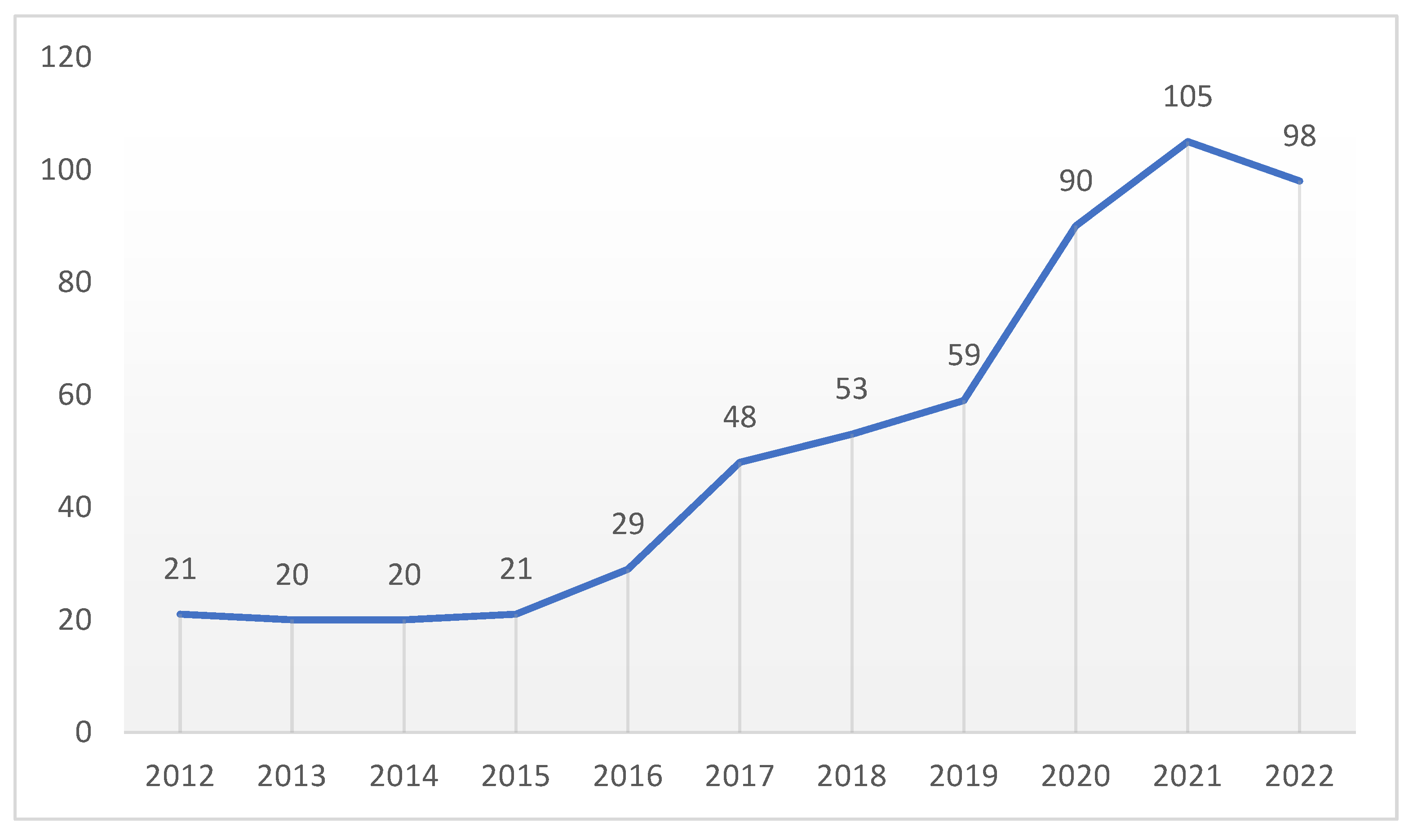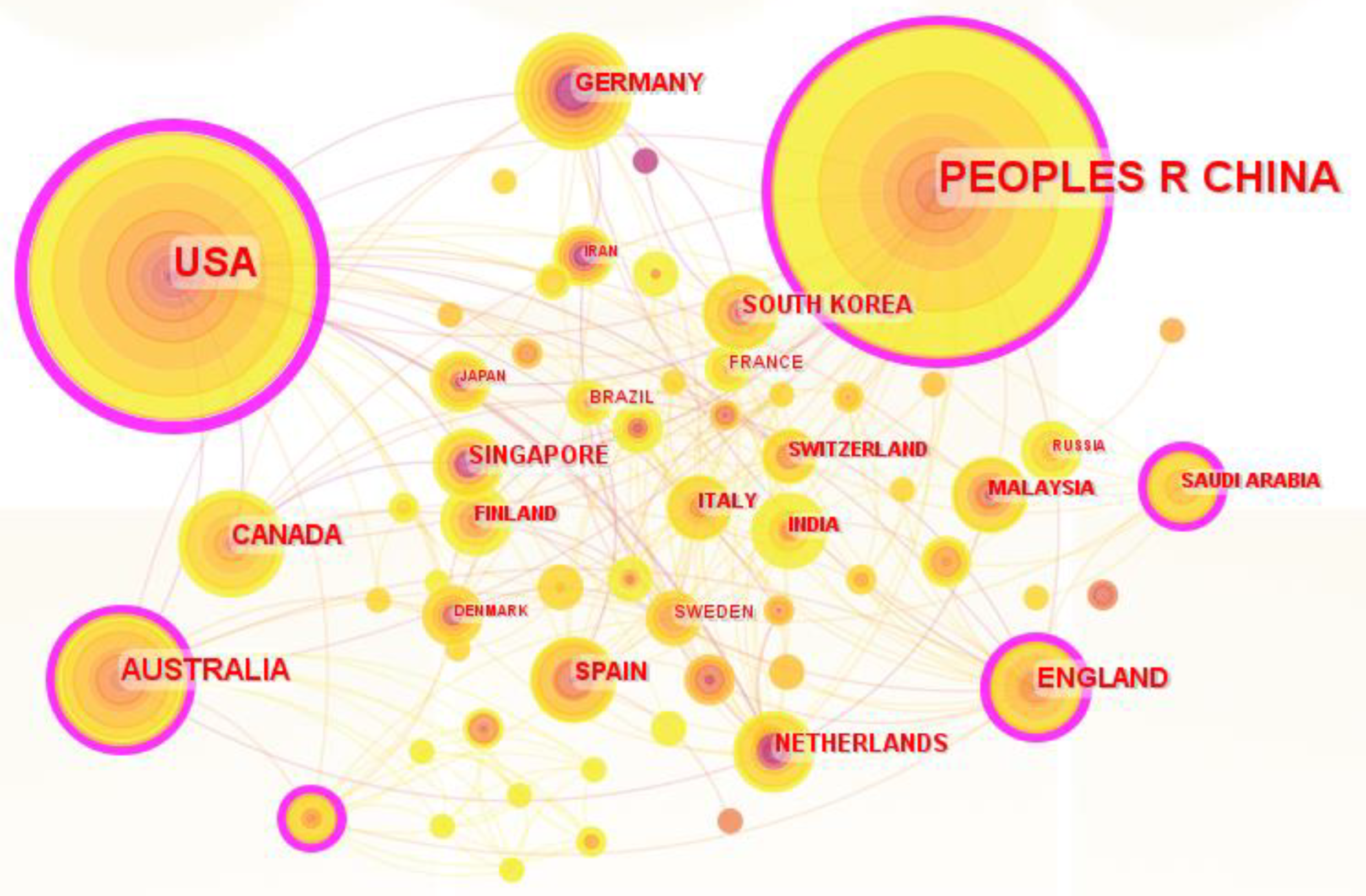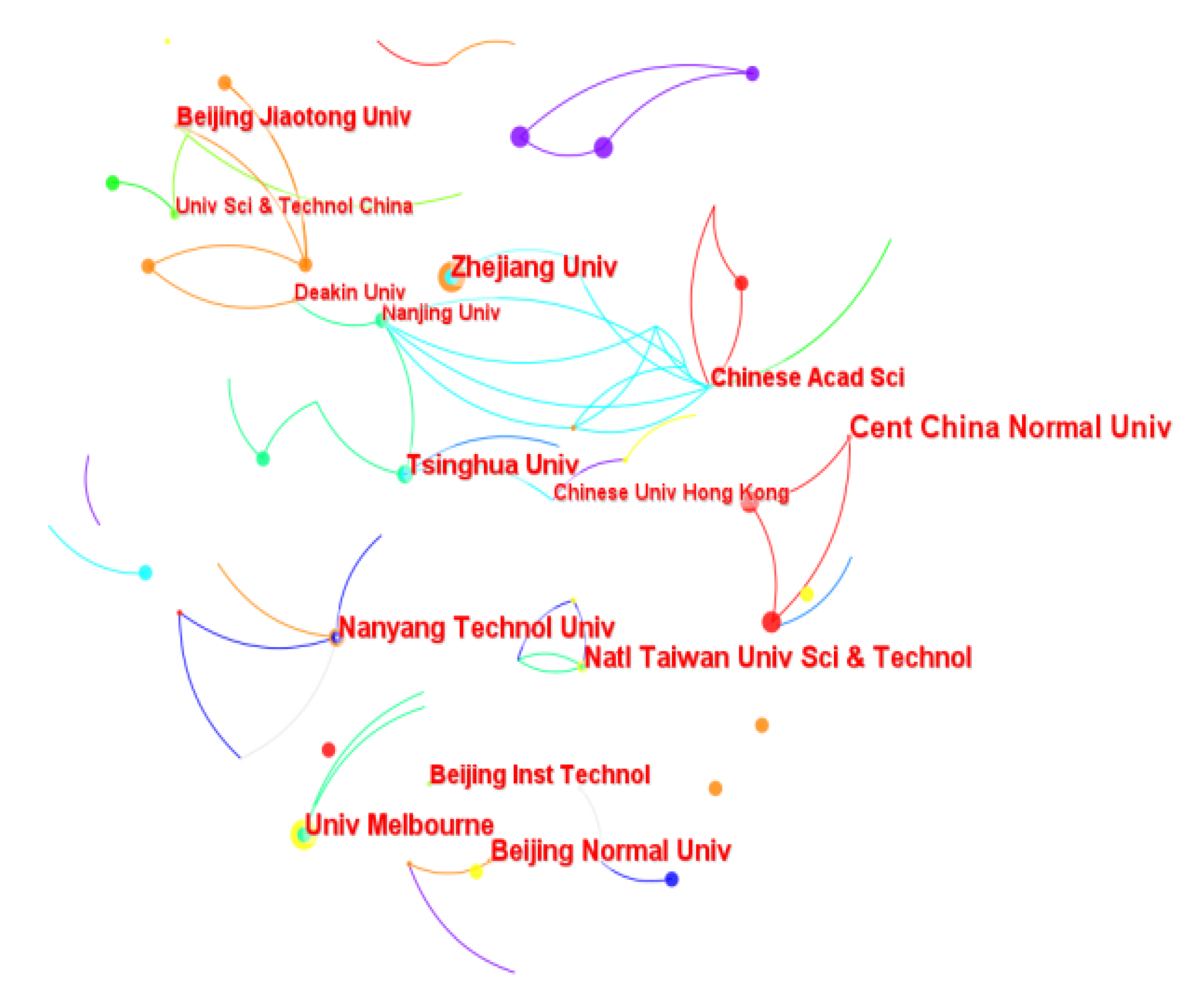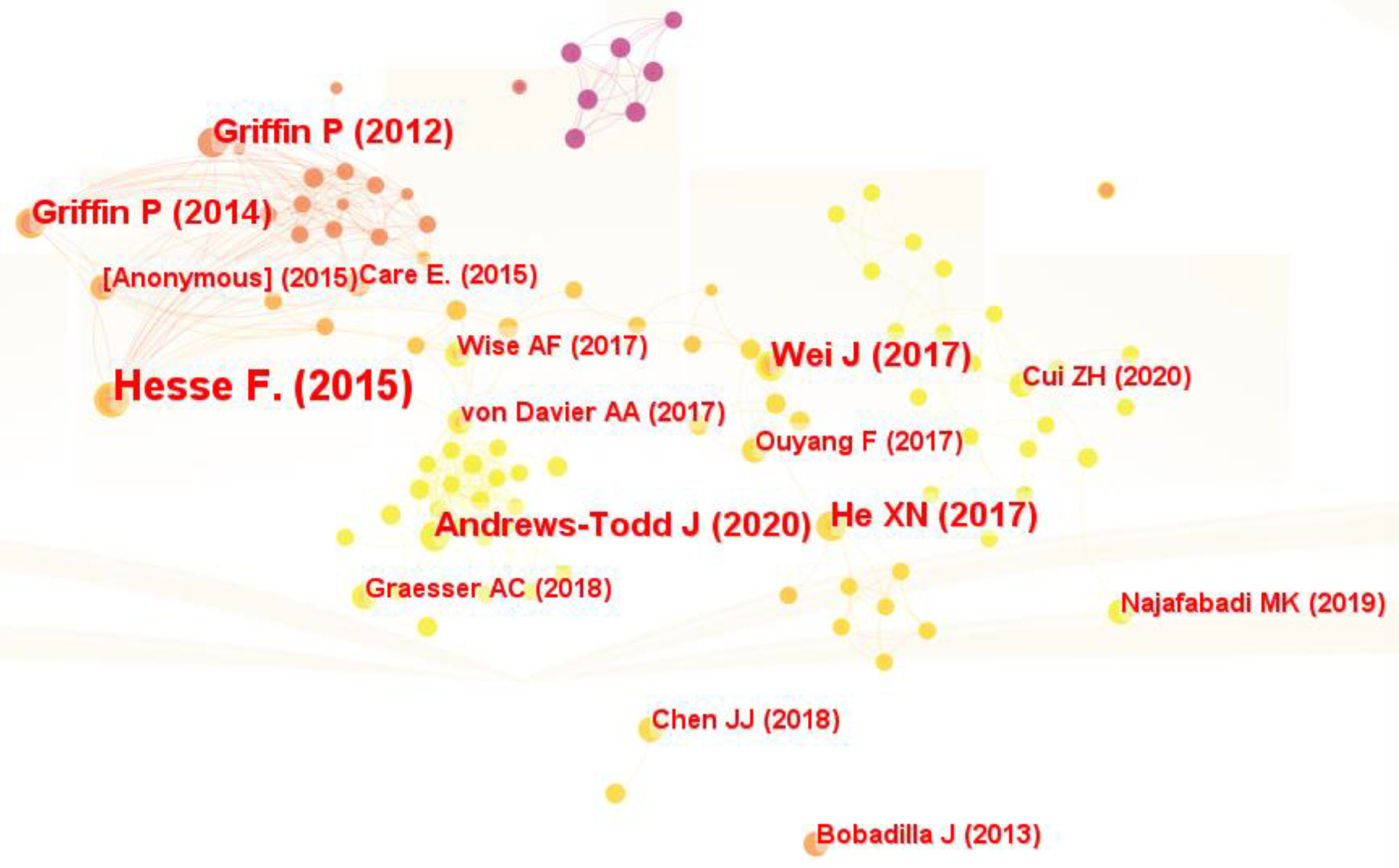Research on Online Collaborative Problem-Solving in the Last 10 Years: Current Status, Hotspots, and Outlook—A Knowledge Graph Analysis Based on CiteSpace
Abstract
:1. Introduction
- Computer-supported collaborative learning,
- The goal of the collaboration is to solve problems,
- To support asynchronous creation, sharing, experience transfer, and guidance,
- Participants experience cognitive and social interaction processes.
2. Research Problems
- (1)
- What is the research status of online collaborative problem-solving?
- (2)
- What are the research hotspots of online collaborative problem-solving?
3. Materials and Methods
4. Results
4.1. Research Status
4.1.1. Number of Papers Published
4.1.2. Authors with High Citation Rates
4.1.3. Highly Cited Journals
4.1.4. The Regional Distribution of the Studies
4.1.5. Co-Citation Analysis
4.2. Research Hotspot
4.2.1. International Research Frontier
4.2.2. Cluster Analysis
4.2.3. Keyword Analysis
5. Discussion
6. Conclusions and Prospect
6.1. Identity Recognition in Online Collaborative Problem-Solving
6.2. Interdisciplinary Online Collaborative Problem-Solving
6.3. Teachers’ Online Collaborative Problem-Solving
6.4. Online Collaborative Problem-Solving and ICT Skills
Author Contributions
Funding
Data Availability Statement
Acknowledgments
Conflicts of Interest
References
- Kaput, J.J.; Thompson, P.W. Technology in mathematics education research: The first 25 years in the JRME. J. Res. Math. Educ. 1994, 25, 676–684. [Google Scholar] [CrossRef]
- Bakker, A.; Cai, J.; Zenger, L. Future Themes of Mathematics Education Research: An International Survey before and during the Pandemic. Educ. Stud. Math. 2021, 107, 1–24. [Google Scholar] [CrossRef] [PubMed]
- Koehler, A.A.; Vilarinho-Pereira, D.R. Using Social Media Affordances to Support Ill-Structured Problem-Solving Skills: Considering Possibilities and Challenges. Educ. Technol. Res. Dev. 2021, 71, 199–235. [Google Scholar] [CrossRef]
- Tawfik, A.A.; Sánchez, L.; Saparova, D. The Effects of Case Libraries in Supporting Collaborative Problem-Solving in an Online Learning Environment. Technol. Knowl. Learn. 2014, 19, 337–358. [Google Scholar] [CrossRef]
- Dowell, N.M.M.; Lin, Y.; Godfrey, A.; Brooks, C. Exploring the Relationship between Emergent Sociocognitive Roles, Collaborative Problem-Solving Skills, and Outcomes: A Group Communication Analysis. J. Learn. Anal. 2020, 7, 38–57. [Google Scholar] [CrossRef]
- Li, S.; Pöysä-Tarhonen, J.; Häkkinen, P. Patterns of Action Transitions in Online Collaborative Problem Solving: A Network Analysis Approach. Int. J. Comput.-Support. Collab. Learn. 2022, 17, 191–223. [Google Scholar] [CrossRef]
- Kube, D.; Weidlich, J.; Jivet, I.; Kreijns, K.; Drachsler, H. “Gendered Differences versus Doing Gender”: A Systematic Review on the Role of Gender in CSCL. Unterrichtswissenschaft 2022, 50, 661–688. [Google Scholar] [CrossRef]
- Järvelä, S.; Veermans, M.; Leinonen, P. Investigating Student Engagement in Computer-Supported Inquiry: A Process-Oriented Analysis. Soc. Psychol. Educ. 2008, 11, 299–322. [Google Scholar] [CrossRef]
- Anderson, T.; Liam, R.; Garrison, D.R.; Archer, W. Assessing Teaching Presence in a Computer Conferencing Context. J. Asynchronous Learn. Netw. 2001, 5, 1–17. [Google Scholar] [CrossRef]
- Jonassen, D.H. Instructional Design Models for Well-Structured and III-Structured Problem-Solving Learning Outcomes. Educ. Technol. Res. Dev. 1997, 45, 65–94. [Google Scholar] [CrossRef]
- Zhang, S.; Che, S.P.; Nan, D.; Kim, J.H. How does online social interaction promote students’ continuous learning intentions? Front. Psychol. 2023, 14, 1098110. [Google Scholar] [CrossRef] [PubMed]
- Baturay, M.H.; Toker, S. The comparison of trust in virtual and face-to-face collaborative learning teams. Turk. Online J. Distance Educ. 2019, 20, 153–164. [Google Scholar] [CrossRef]
- Andersen, R.; Rustad, M. Using Minecraft as an Educational Tool for Supporting Collaboration as a 21st Century Skill. Comput. Educ. Open 2022, 3, 100094. [Google Scholar] [CrossRef]
- OECD. PISA 2015 Assessment and Analytical Framework: Science, Reading, Mathematic, Financial Literacy and Collaborative Problem Solving; revised edition; PISA, OECD Publishing: Paris, France, 2017. [Google Scholar]
- Jia, H.; Yang, L.; Cui, B. Collaborative filtering recommendation of online learning resources based on knowledge association model. Int. J. Emerg. Technol. Learn. 2022, 17, 158–172. [Google Scholar] [CrossRef]
- Shute, V.J.; Rahimi, S. Review of Computer-based Assessment for Learning in Elementary and Secondary Education. J. Comput. Assist. Learn. 2017, 33, 1–19. [Google Scholar] [CrossRef]
- Mo, J.P.T.; Tang, Y.M. Project-based learning of systems engineering V model with the support of 3D printing. Australas. J. Eng. Educ. 2017, 22, 3–13. [Google Scholar] [CrossRef]
- Tang, Y.M.; Chau, K.Y.; Kwok, A.P.K.; Zhu, T.; Ma, X. A systematic review of immersive technology applications for medical practice and education—Trends, application areas, recipients, teaching contents, evaluation methods, and performance. Educ. Res. Rev. 2022, 35, 100429. [Google Scholar] [CrossRef]
- Sun, C.; Shute, V.J.; Stewart, A.; Yonehiro, J.; Duran, N.; D’Mello, S. Towards a generalized competency model of collaborative problem solving. Comput. Educ. 2020, 143, 103672. [Google Scholar] [CrossRef]
- Isotani, S.; Inaba, A.; Ikeda, M.; Mizoguchi, R. An Ontology Engineering Approach to the Realization of Theory-Driven Group Formation. Int. J. Comput.-Support. Collab. Learn. 2009, 4, 445–478. [Google Scholar] [CrossRef]
- Pruner, M.; Liljedahl, P. Collaborative Problem Solving in a Choice-Affluent Environment. ZDM-Math. Educ. 2021, 53, 753–770. [Google Scholar] [CrossRef]
- Roschelle, J.; Teasley, S.D. The Construction of Shared Knowledge in Collaborative Problem Solving. In Computer Supported Collaborative Learning; Springer: Cham, Switzerland, 1995; pp. 69–97. [Google Scholar]
- Barron, B. When Smart Groups Fail. J. Learn. Sci. 2003, 12, 307–359. [Google Scholar] [CrossRef]
- Binkley, M.; Erstad, O.; Herman, J.; Raizen, S.; Ripley, M.; Miller-Ricci, M.; Rumble, M. Defining Twenty-First Century Skills. In Assessment and Teaching of 21st Century Skills; Springer: Dordrecht, The Netherlands, 2012; pp. 17–66. [Google Scholar]
- Zheng, Y.; Bao, H.; Shen, J.; Zhai, X. Investigating Sequence Patterns of Collaborative Problem-Solving Behavior in Online Collaborative Discussion Activity. Sustainability 2020, 12, 8522. [Google Scholar] [CrossRef]
- Isohätälä, J.; Näykki, P.; Järvelä, S.; Baker, M.J.; Lund, K. Social Sensitivity: A Manifesto for CSCL Research. Int. J. Comput.-Support. Collab. Learn. 2021, 16, 289–299. [Google Scholar] [CrossRef] [PubMed]
- Han, A.; Krieger, F.; Greiff, S. Collaboration Analytics Need More Comprehensive Models and Methods. An Opinion Paper. J. Learn. Anal. 2021, 8, 13–29. [Google Scholar] [CrossRef]
- Broadus, R.N. Toward a Definition of “Bibliometrics”. Scientometrics 1987, 12, 373–379. [Google Scholar] [CrossRef]
- Chen, C. CiteSpace II: Detecting and Visualizing Emerging Trends and Transient Patterns in Scientific Literature. J. Am. Soc. Inf. Sci. Technol. 2006, 57, 359–377. [Google Scholar] [CrossRef]
- Stadler, M.; Herborn, K.; Mustafić, M.; Greiff, S. The Assessment of Collaborative Problem Solving in PISA 2015: An Investigation of the Validity of the PISA 2015 CPS Tasks. Comput. Educ. 2020, 157, 103964. [Google Scholar] [CrossRef]
- Lin, C.-L.; Hou, H.-T.; Tsai, C.-C. Analyzing the Social Knowledge Construction and Online Searching Behavior of High School Learners during a Collaborative Problem Solving Learning Activity: A Multi-Dimensional Behavioral Pattern Analysis. Asia-Pac. Educ. Res. 2016, 25, 893–906. [Google Scholar] [CrossRef]
- Lin, L.; Mills, L.A.; Ifenthaler, D. Collaboration, Multi-Tasking and Problem Solving Performance in Shared Virtual Spaces. J. Comput. High. Educ. 2016, 28, 344–357. [Google Scholar] [CrossRef]
- Dossey, J.A.; Funke, J. Canadian and United States Students’ Performances on the OECD’s PISA 2012 Problem-Solving Assessment. Can. J. Sci. Math. Technol. Educ. 2016, 16, 92–108. [Google Scholar] [CrossRef]
- OECD. PISA 2012 Results: Creative Problem Solving: Students’ Skills in Tackling Real-Life Problems (Volume V); OECD Publishing: Pisa, Italy, 2014. [Google Scholar]
- She, H.C.; Stacey, K.; Schmidt, W.H. Science and Mathematics Literacy: PISA for Better School Education. Int. J. Sci. Math. Educ. 2018, 16, 1–5. [Google Scholar] [CrossRef]
- Huang, J.; Hmelo-Silver, C.E.; Jordan, R.; Gray, S.; Frensley, T.; Newman, G.; Stern, M.J. Scientific Discourse of Citizen Scientists: Models as a Boundary Object for Collaborative Problem Solving. Comput. Hum. Behav. 2018, 87, 480–492. [Google Scholar] [CrossRef]
- Available online: https://www.sciencedirect.com/journal/computers-and-education (accessed on 16 March 2023).
- Available online: https://www.editorialmanager.com/chb/default2.aspx (accessed on 26 April 2023).
- Hesse, F.; Care, E.; Buder, J.; Sassenberg, K.; Griffin, P. A Framework for Teachable Collaborative Problem Solving Skills. In Assessment and Teaching of 21st Century Skills: Methods and Approach; Springer: Berlin/Heidelberg, Germany, 2015; pp. 37–56. [Google Scholar]
- Koduru, A.; Valiveti, H.B.; Budati, A.K. Feature Extraction Algorithms to Improve the Speech Emotion Recognition Rate. Int. J. Speech Technol. 2020, 23, 45–55. [Google Scholar] [CrossRef]
- McConomy, M.A.; Root, J.; Wade, T. Using Task Analysis to Support Inclusion and Assessment in the Classroom. TEACHING Except. Child. 2022, 54, 414–422. [Google Scholar] [CrossRef]
- Andrews-Todd, J.; Forsyth, C.M. Exploring social and cognitive dimensions of collaborative problem solving in an open online simulation-based task. Comput. Hum. Behav. 2020, 104, 105759. [Google Scholar] [CrossRef]
- Filippou, D.; Buchs, C.; Quiamzade, A.; Pulfrey, C. Understanding Motivation for Implementing collaborative Learning Methods: A Value-Based Approach. Soc. Psychol. Educ. 2022, 25, 169–208. [Google Scholar] [CrossRef]
- Lu, J.; Wu, S.; Wang, Y.; Zhang, Y. Visualizing the Commognitive Processes of Collaborative Problem Solving in Mathematics Classrooms. Asia-Pac. Educ. Res. 2022, 1–14. [Google Scholar] [CrossRef]
- Griffin, P.; Wilson, M.; Care, E. Assessment and Teaching of 21st Century Skills: Research and Applications; Springer: Cham, Switzerland, 2018. [Google Scholar]
- Seel, N.M. Encyclopedia of the Sciences of Learning; Springer Science & Business Media: New York, NY, USA, 2011; pp. 682–685. [Google Scholar]
- Amigues, R.; Agostinelli, S. Collaborative Problem-Solving with a Computer: How Can an Interactive Learning Environment Be Designed? Eur. J. Psychol. Educ. 1992, 7, 325–337. [Google Scholar] [CrossRef]
- Hou, H.-T. A Case Study of Online Instructional Collaborative Discussion Activities for Problem-Solving Using Situated Scenarios: An Examination of Content and Behavior Cluster Analysis. Comput. Educ. 2011, 56, 712–719. [Google Scholar] [CrossRef]
- Dillenbourg, P.; Baker, M.; Blaye, A.; O’malley, C. The Evolution of Research on Collaborative Learning. In Learning in Humans and Machines; Spada, H., Reimann, P., Eds.; Elsevier: Amsterdam, The Netherlands, 1996; Volume 1, pp. 58–94. [Google Scholar]
- Giesbers, B. Adding eyebrows to CSCL; understanding the combined use of synchronous and asynchronous communication, and the role of motivation in computer-supported collaborative learning. Perspect. Med. Educ. 2014, 3, 312–313. [Google Scholar] [CrossRef]
- Weinberger, A.; Ertl, B.; Fischer, F.; Mandl, H. Epistemic and Social Scripts in Computer–Supported Collaborative Learning. Instr. Sci. 2005, 33, 1–30. [Google Scholar] [CrossRef]
- Asino, T.I.; Pulay, A. Student Perceptions on the Role of the Classroom Environment on Computer Supported Collaborative Learning. TechTrends 2019, 63, 179–187. [Google Scholar] [CrossRef]
- Schnaubert, L.; Vogel, F. Integrating Collaboration Scripts, Group Awareness, and Self-Regulation in Computer-Supported Collaborative Learning. Int. J. Comput.-Support. Collab. Learn. 2022, 17, 1–10. [Google Scholar] [CrossRef]
- Baker, M.J.; Schwarz, B.B.; Ludvigsen, S.R. Educational Dialogues and Computer Supported Collaborative Learning: Critical Analysis and Research Perspectives. Int. J. Comput.-Support. Collab. Learn. 2021, 16, 583–604. [Google Scholar] [CrossRef]
- Tang, H.; Wang, Q.; Jiang, G. Discrete Dynamic Modeling Analysis Based on English Learning Motivation. Math. Probl. Eng. 2022, 2022, 6995411. [Google Scholar] [CrossRef]
- Chen, X.; Deng, H. Research on personalized recommendation methods for online video learning resources. Appl. Sci. 2021, 11, 804. [Google Scholar] [CrossRef]
- Xia, X.; Chen, F.; He, Q.; Grundy, J.; Abdelrazek, M.; Jin, H. Online Collaborative Data Caching in Edge Computing. IEEE Trans. Parallel Distrib. Syst. 2020, 32, 281–294. [Google Scholar] [CrossRef]
- Guazzini, A.; Duradoni, M.; Lazzeri, A.; Gronchi, G. Simulating the Cost of Cooperation: A Recipe for Collaborative Problem-Solving. Future Internet 2018, 10, 55. [Google Scholar] [CrossRef]
- Sadeghi, H.; Kardan, A.A. Toward Effective Group Formation in Computer-Supported Collaborative Learning. Interact. Learn. Environ. 2016, 24, 382–395. [Google Scholar] [CrossRef]
- Dowell, N.M.M.; Nixon, T.M.; Graesser, A.C. Group Communication Analysis: A Computational Linguistics Approach for Detecting Sociocognitive Roles in Multiparty Interactions. Behav. Res. Methods 2019, 51, 1007–1041. [Google Scholar] [CrossRef]
- Wang, S.-M.; Hou, H.-T.; Wu, S.-Y. Analyzing the Knowledge Construction and Cognitive Patterns of Blog-Based Instructional Activities Using Four Frequent Interactive Strategies (Problem Solving, Peer Assessment, Role Playing and Peer Tutoring): A Preliminary Study. Educ. Technol. Res. Dev. 2017, 65, 301–323. [Google Scholar] [CrossRef]
- Wu, S.-Y. Incorporation of Collaborative Problem Solving and Cognitive Tools to Improve Higher Cognitive Processing in Online Discussion Environments. J. Educ. Comput. Res. 2020, 58, 249–272. [Google Scholar] [CrossRef]
- Li, X.; Cox, A.; Ford, N. Knowledge Construction by Users: A Content Analysis Framework and a Knowledge Construction Process Model for Virtual Product User Communities. J. Doc. 2017, 73, 284–304. [Google Scholar] [CrossRef]
- Xu, L.; Jiang, C.; He, N.; Han, Z.; Benslimane, A. Trust-Based Collaborative Privacy Management in Online Social Networks. IEEE Trans. Inf. Secur. 2018, 14, 48–60. [Google Scholar] [CrossRef]
- Song, Y. Improving Primary Students’ Collaborative Problem Solving Competency in Project-Based Science Learning with Productive Failure Instructional Design in a Seamless Learning Environment. Educ. Technol. Res. Dev. 2018, 66, 979–1008. [Google Scholar] [CrossRef]
- Hendarwati, E.; Nurlaela, L.; Bachri, B.; Sa’ida, N. Collaborative Problem Based Learning Integrated with Online Learning. Int. J. Emerg. Technol. Learn. (IJET) 2021, 16, 29–39. [Google Scholar] [CrossRef]
- Rosen, Y. Computer-Based Assessment of Collaborative Problem Solving: Exploring the Feasibility of Human-to-Agent Approach. Int. J. Artif. Intell. Educ. 2015, 25, 380–406. [Google Scholar] [CrossRef]
- Xu, C.; Zheng, Y.; Hu, H.; Li, Y. Exploring Individual Contributions during Online Collaborative Discussions. J. Comput. Educ. 2016, 3, 395–411. [Google Scholar] [CrossRef]
- Tsovaltzi, D.; Judele, R.; Puhl, T.; Weinberger, A. Scripts, Individual Preparation and Group Awareness Support in the Service of Learning in Facebook: How Does CSCL Compare to Social Networking Sites? Comput. Hum. Behav. 2015, 53, 577–592. [Google Scholar] [CrossRef]
- Smith Risser, H.; Bottoms, S. “Newbies” and “Celebrities”: Detecting Social Roles in an Online Network of Teachers via Participation Patterns. Int. J. Comput.-Support. Collab. Learn. 2014, 9, 433–450. [Google Scholar] [CrossRef]
- Scoular, C.; Care, E. Monitoring Patterns of Social and Cognitive Student Behaviors in Online Collaborative Problem Solving Assessments. Comput. Hum. Behav. 2020, 104, 105874. [Google Scholar] [CrossRef]
- Chu, H.C.; Chen, J.M.; Tsai, C.L. Effects of an online formative peer-tutoring approach on students’ learning behaviors, performance and cognitive load in mathematics. In Learning Analytics; Routledge: London, UK, 2018; pp. 61–77. [Google Scholar]
- Lim, C.; Han, H. Development of Instructional Design Strategies for Integrating an Online Support System for Creative Problem Solving into a University Course. Asia Pac. Educ. Rev. 2020, 21, 539–552. [Google Scholar] [CrossRef]
- Koehler, A.A.; Cheng, Z.; Fiock, H.; Wang, H.; Janakiraman, S.; Chartier, K. Examining Students’ Use of Online Case-Based Discussions to Support Problem Solving: Considering Individual and Collaborative Experiences. Comput. Educ. 2022, 179, 104407. [Google Scholar] [CrossRef]
- Zhang, S.; Gao, Q.; Sun, M.; Cai, Z.; Li, H.; Tang, Y.; Liu, Q. Understanding Student Teachers’ Collaborative Problem Solving: Insights from an Epistemic Network Analysis (ENA). Comput. Educ. 2022, 183, 104485. [Google Scholar] [CrossRef]
- Kapur, M. Temporality Matters: Advancing a Method for Analyzing Problem-Solving Processes in a Computer-Supported Collaborative Environment. Int. J. Comput.-Support. Collab. Learn. 2011, 6, 39–56. [Google Scholar] [CrossRef]
- Tang, H.; Dai, M.; Yang, S.; Du, X.; Hung, J.-L.; Li, H. Using Multimodal Analytics to Systemically Investigate Online Collaborative Problem-Solving. Distance Educ. 2022, 43, 290–317. [Google Scholar] [CrossRef]
- Du, X.; Zhang, L.; Hung, J.L.; Li, H.; Tang, H.; Xie, Y. Understand Group Interaction and Cognitive State in Online Collaborative Problem Solving: Leveraging Brain-to-Brain Synchrony Data. Int. J. Educ. Technol. High. Educ. 2022, 19, 52. [Google Scholar] [CrossRef]
- Ouyang, F.; Chen, Z.; Cheng, M.; Tang, Z.; Su, C.-Y. Exploring the Effect of Three Scaffoldings on the Collaborative Problem-Solving Processes in China’s Higher Education. Int. J. Educ. Technol. High. Educ. 2021, 18, 35. [Google Scholar] [CrossRef]
- Unal, E.; Cakir, H. The Effect of Technology-Supported Collaborative Problem Solving Method on Students’ Achievement and Engagement. Educ. Inf. Technol. 2021, 26, 4127–4150. [Google Scholar] [CrossRef]
- Cheng, Z.; Long, Y.; Koehler, A.A. Supporting Problem Solving with Asynchronous Online Discussions: A Social Network Analysis. Educ. Technol. Res. Dev. 2022, 70, 737–763. [Google Scholar] [CrossRef]
- Moustafa, F.; Steed, A. A Longitudinal Study of Small Group Interaction in Social Virtual Reality. In Proceedings of the 24th ACM Symposium on Virtual Reality Software and Technology, Tokyo, Japan, 28 November–1 December 2018; pp. 1–10. [Google Scholar]
- Goldman, S.R.; Braasch, J.L.G.; Wiley, J.; Graesser, A.C.; Brodowinska, K. Comprehending and Learning from Internet Sources: Processing Patterns of Better and Poorer Learners. Read. Res. Q. 2012, 47, 356–381. [Google Scholar]
- Coursey, L.E.; Williams, B.C.; Kenworthy, J.B.; Paulus, P.B.; Doboli, S. Divergent and Convergent Group Creativity in an Asynchronous Online Environment. J. Creat. Behav. 2020, 54, 253–266. [Google Scholar] [CrossRef]
- Azarova, M.; Hazoglou, M.; Aronoff-Spencer, E. Just Slack It: A Study of Multidisciplinary Teamwork Based on Ethnography and Data from Online Collaborative Software. New Media Soc. 2022, 24, 1435–1458. [Google Scholar] [CrossRef]
- Mo, G.Y. Examining Cross-Disciplinary Communication’s Impact on Multidisciplinary Collaborations: Implications for Innovations. Inf. Commun. Soc. 2016, 19, 673–690. [Google Scholar] [CrossRef]
- Vuojärvi, H.; Vartiainen, H.; Eriksson, M.; Ratinen, I.; Saramäki, K.; Torssonen, P.; Vanninen, P.; Pöllänen, S. Boundaries and Boundary Crossing in a Multidisciplinary Online Higher Education Course on Forest Bioeconomy. Teach. High. Educ. 2022, 1–18. [Google Scholar] [CrossRef]
- Francis, K.; Jacobsen, M. Synchronous Online Collaborative Professional Development for Elementary Mathematics Teachers. Int. Rev. Res. Open Distrib. Learn. 2013, 14, 319–343. [Google Scholar] [CrossRef]
- Alzayed, Z.A.; Alabdulkareem, R.H. Enhancing Cognitive Presence in Teachers’ Professional Learning Communities via Reflective Practice. J. Educ. Teach. 2021, 47, 18–31. [Google Scholar] [CrossRef]
- Zhou, X.; Tsai, C.-W. The Effects of Socially Shared Regulation of Learning on the Computational Thinking, Motivation, and Engagement in Collaborative Learning by Teaching. Educ. Inf. Technol. 2022, 1–18. [Google Scholar] [CrossRef]






| Ranking | Author/Organization | Frequency |
|---|---|---|
| 1 | OECD | 28 |
| 2 | Hmelo-Silver C.E | 24 |
| 3 | Hou H.T | 20 |
| 4 | Roschelle J | 20 |
| 5 | Jonassen D.H | 19 |
| 6 | Griffin P | 16 |
| 7 | Braun Virginia | 16 |
| 8 | Jeong H | 15 |
| 9 | Koren Y | 15 |
| 10 | Hesse F | 15 |
| Ranking | Journal | Frequency |
|---|---|---|
| 1 | COMPUT EDUC | 154 |
| 2 | COMPUT HUM BEHAV | 119 |
| 3 | LECT NOTES COMPUT SC | 105 |
| 4 | ETR&D-EDUC TECH RES | 84 |
| 5 | EDUC TECHNOL SOC | 69 |
| 6 | IEEE ACCESS | 68 |
| 7 | BRIT J EDUC TECHNOL | 63 |
| 8 | EXPERT SYST APPL | 63 |
| 9 | INT J COMP-SUPP COLL | 62 |
| 10 | J COMPUT ASSIST LEAR | 58 |
| Ranking | Country | Frequency |
|---|---|---|
| 1 | China | 232 |
| 2 | USA | 158 |
| 3 | Australia | 36 |
| 4 | Canada | 30 |
| 5 | England | 29 |
| 6 | Germany | 23 |
| 7 | Spain | 17 |
| 8 | Netherlands | 15 |
| 9 | South Korea | 14 |
| 10 | Singapore | 13 |
| Ranking | Institution | Frequency |
|---|---|---|
| 1 | Central China Normal University | 8 |
| 2 | National Taiwan University of Science and Technology | 7 |
| 3 | University of Melbourne | 7 |
| 4 | Zhejiang University | 7 |
| 5 | Nanyang Technological University | 7 |
| 6 | Beijing Normal University | 7 |
| 7 | Tsinghua University | 6 |
| 8 | Beijing University of Posts and Telecommunication | 5 |
| 9 | Beijing Jiaotong University | 5 |
| 10 | Chinese Academy of Science | 5 |
| Ranking | Keywords | Co-Cited Frequency |
|---|---|---|
| 1 | system | 49 |
| 2 | collaborative learning | 43 |
| 3 | online | 42 |
| 4 | student | 41 |
| 5 | model | 35 |
| 6 | education | 31 |
| 7 | collaborative filtering | 31 |
| 8 | framework | 29 |
| 9 | design | 25 |
| 10 | knowledge | 25 |
Disclaimer/Publisher’s Note: The statements, opinions and data contained in all publications are solely those of the individual author(s) and contributor(s) and not of MDPI and/or the editor(s). MDPI and/or the editor(s) disclaim responsibility for any injury to people or property resulting from any ideas, methods, instructions or products referred to in the content. |
© 2023 by the authors. Licensee MDPI, Basel, Switzerland. This article is an open access article distributed under the terms and conditions of the Creative Commons Attribution (CC BY) license (https://creativecommons.org/licenses/by/4.0/).
Share and Cite
Jiang, P.; Ruan, X.; Feng, Z.; Jiang, Y.; Xiong, B. Research on Online Collaborative Problem-Solving in the Last 10 Years: Current Status, Hotspots, and Outlook—A Knowledge Graph Analysis Based on CiteSpace. Mathematics 2023, 11, 2353. https://doi.org/10.3390/math11102353
Jiang P, Ruan X, Feng Z, Jiang Y, Xiong B. Research on Online Collaborative Problem-Solving in the Last 10 Years: Current Status, Hotspots, and Outlook—A Knowledge Graph Analysis Based on CiteSpace. Mathematics. 2023; 11(10):2353. https://doi.org/10.3390/math11102353
Chicago/Turabian StyleJiang, Peijie, Xiaomeng Ruan, Zirong Feng, Yanyun Jiang, and Bin Xiong. 2023. "Research on Online Collaborative Problem-Solving in the Last 10 Years: Current Status, Hotspots, and Outlook—A Knowledge Graph Analysis Based on CiteSpace" Mathematics 11, no. 10: 2353. https://doi.org/10.3390/math11102353
APA StyleJiang, P., Ruan, X., Feng, Z., Jiang, Y., & Xiong, B. (2023). Research on Online Collaborative Problem-Solving in the Last 10 Years: Current Status, Hotspots, and Outlook—A Knowledge Graph Analysis Based on CiteSpace. Mathematics, 11(10), 2353. https://doi.org/10.3390/math11102353






